"We came in the afternoon to Slanes* Castle, built upon the margin of the sea, so that the walls of one of the towers seem only a continuation of a perpendicular rock, the foot of which is beaten by the waves. To walk round the house seemed impracticable. From the windows the eye wanders over the sea that separates Scotland from Norway, and when the winds beat with violence must enjoy all the terrifick grandeur of the tempestuous ocean. I would not for my amusement wish for a storm; but as storms, whether wished or not, will sometimes happen, I may say, without violation of humanity, that I should willingly look out upon them from Slanes Castle." -- Samuel Johnson, A Journey to the Western Isles of ScotlandFrom the Bullers
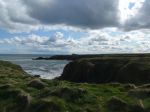 you
can just see it
you
can just see it 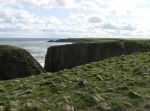 and
and 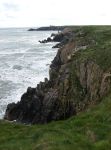 as you walk along
as you walk along  the cliffs
the cliffs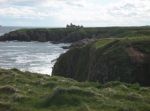 and the
and the  yawns it looms larger
yawns it looms larger  and larger
and larger  until you're
there
until you're
there  and words start to
fail you.This is about half the pictures we took and there's not much to
be said about them.
and words start to
fail you.This is about half the pictures we took and there's not much to
be said about them.




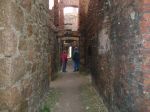















What's especially amazing is that in 1773, when Johnson and James Boswell
visited it, on their way to the Western Isles, it was still in use. Here's
some of what he said
.
We had received a polite invitation to Slains castle. We arrived there just at three o’clock, as the bell for dinner was ringing. Though, from its being just on the north-east Ocean, no trees will grow here, Lord Errol has done all that can be done. He has cultivated his fields so as to bear rich crops of every kind, and he has made an excellent kitchen-garden, with a hot-house. I had never seen any of the family: but there had been a card of invitation written by the honourable Charles Boyd, the earl’s brother. We were conducted into the house, and at the dining-room door were met by that gentleman, whom both of us at first took to be Lord Errol; but he soon corrected our mistake. My lord was gone to dine in the neighbourhood, at an entertainment given by Mr Irvine of Drum. Lady Errol received us politely, and was very attentive to us during the time of dinner. There was nobody at table but her ladyship, Mr Boyd, and some of the children, their governour and governess. Mr Boyd put Dr Johnson in mind of having dined with him at Cumming the Quaker’s, along with Mr Hall and Miss Williams: this was a bond of connection between them. For me, Mr Boyd’s acquaintance with my father was enough. After dinner, Lady Errol favoured us with a sight of her young family, whom she made stand up in a row. There were six daughters and two sons. It was a very pleasing sight.
Dr Johnson proposed our setting out. Mr Boyd said, he hoped we would stay all night; his brother would be at home in the evening, and would be very sorry if he missed us. Mr Boyd was called out of the room. I was very desirous to stay in so comfortable a house, and I wished to see Lord Errol. Dr Johnson, however, was right in resolving to go, if we were not asked again, as it is best to err on the safe side in such cases, and to be sure that one is quite welcome. To my great joy, when Mr Boyd returned, he told Dr Johnson that it was Lady Errol who had called him out, and said that she would never let Dr Johnson into the house again, if he went away that night; and that she had ordered the coach, to carry us to view a great curiosity on the coast, after which we should see the house. We cheerfully agreed.
[Where they went was to the "Bullers," which you can read about here.]
When we returned to the house we found coffee and tea in the drawing-room. Lady Errol was not there, being, as I supposed, engaged with her young family. There is a bow-window fronting the sea. . . . This room is ornamented with a number of fine prints, and with a whole length picture of Lord Errol, by Sir Joshua Reynolds. . . . Dr Johnson observed, the situation here was the noblest he had ever seen, better than Mount Edgecumbe, reckoned the first in England; because, at Mount Edgecumbe, the sea is bounded by land on the other side, and, though there is there the grandeur of a fleet, there is also the impression of there being a dock-yard, the circumstances of which are not agreeable. At Slains is an excellent old house. The noble owner has built of brick, along the square in the inside, a gallery, both on the first and second story, the house being no higher; so that he has always a dry walk, and the rooms, to which formerly there was no approach but through each other, have now all separate entries from the gallery, which is hung with Hogarth’s works, and other prints. We went and sat a while in the library. There is a valuable numerous collection. It was chiefly made by Mr Falconer, husband to the late Countess of Errol in her own right. This earl has added a good many modern books.. . . I had a most elegant room; but there was a fire in it which blazed; and the sea, to which my windows looked, roared; and the pillows were made of the feathers of some sea-fowl, which had to me a disgreeable smell: so that, by all these causes, I was kept awake a good while. I saw, in imagination, Lord Errol’s father, Lord Kilmarnock (who was beheaded on Tower Hill in 1746), and I was somewhat dreary. But the thought did not last long, and I fell asleep. -- Journal of a Tour to the Hebrides
*Johnson spelled it that way. I don't know which
is right, but the modern one is "Slains."